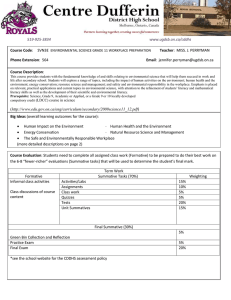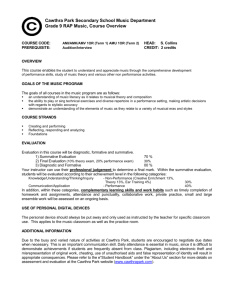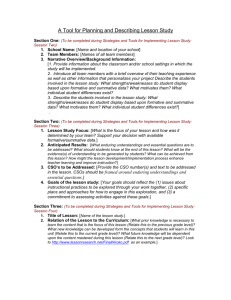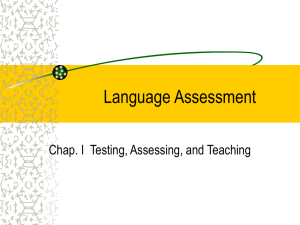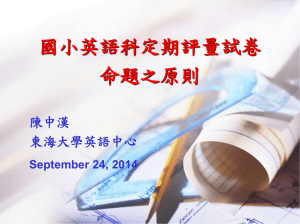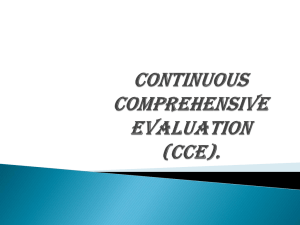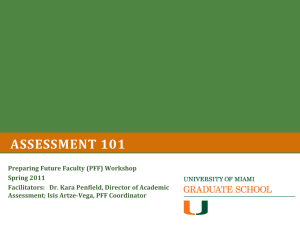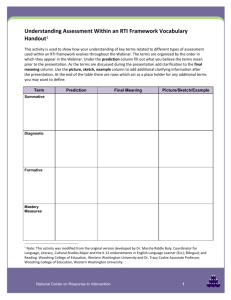Document
advertisement
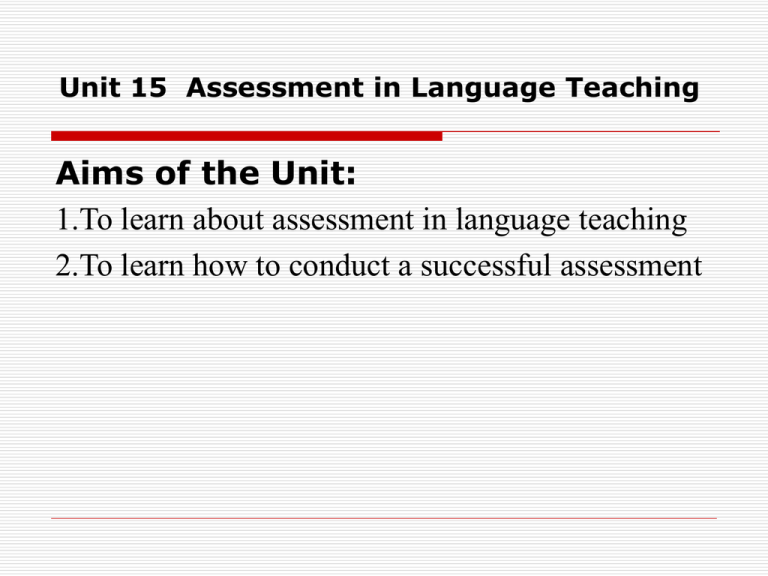
Unit 15 Assessment in Language Teaching Aims of the Unit: 1.To learn about assessment in language teaching 2.To learn how to conduct a successful assessment 15.1 The assessment purposes Assessment in ELT means to discover what the learners know and can do at a certain stage of the learning process. 1. To assist student learning. 2. To identify students’ strengths and weaknesses. 3.To assess the effectiveness of a particular instructional strategy. 4. To assess and improve the effectiveness of curriculum programs. 5. To assess and improve teaching effectiveness. 6. To provide data that assist in decision making 7. To communicate with and involve parents 15.2 Assessment in language teaching 1. Methods of assessment 1) Assessment and test * Assessment is usually based on information collected about the learners’ current situation( what Ss know and can do ). * Testing is a single-occasion, unidimensional, timed exercise, usually in multiple choice or short-answer form 2) Assessment methods Test Teacher’s observations Continuous assessment Self-assessment & peer-assessment Project work Portfolios 15.3 Criteria for assessment 1) Criterion-referenced assessment 2) Norm-referenced assessment 3) Individual-referenced assessment 4)How to assess portfolios 15.4 Assessment principles Assess authentic use of language in reading, writing, speaking and listening; Assess literacy and language in a variety of contexts; Assess the environment, the instruction, and the students; Assess processes as well as products; Analyze patterns of errors in language and literacy; Be based on normal development patterns and behavior in language and literacy acquisition; Clarify and use standards when assessing reading, writing and content knowledge; Involve Ss and parents, as well as other personnel such as the ESL or stream teacher, in the assessment process; Be an ongoing part of every day. 15.5 Types of assessment 1. Types of Assessment Three common types of assessment: Diagnostic Assessment Formative Assessment Summative Assessment 1) Diagnostic Assessment (诊断性评价) The purpose of diagnostic assessment is to ascertain, prior to instruction, each student’s strengths, weaknesses, knowledge, and skills. Diagnostic assessment is sometimes taken as a component of formative assessment. 2) Formative Assessment(形成性评价) Formative assessment is often done at the beginning or during a program, thus providing the opportunity for immediate evidence for student learning in a particular course or at a particular point in a program. The goal : is to gain an understanding of what students know (and don't know) in order to make responsive changes in teaching and learning. The results : is solely to modify and adjust his or her teaching practices to reflect the needs and progress of his or her students 3) Summative Assessment (终结性评价) Summative assessment is a test, usually given at the end of a term, chapter, semester, year, or the like, the purpose of which is evaluative Summative assessments can shape how teachers organize their courses or what schools offer their students, and can adversely affect students. 2. Assessment methods suggested by New English Curriculum Standard 1) Ideas of assessment promoted by NECS a. Assessment should be incentive and constructive for the overall development of students. b.Assessment and language teaching should correspond with each other. c.A combined use of formative and summative assessments should be promoted. 2) Assessment content Ss’ Learning interest(学习兴趣) Changes of emotions and learning strategies (情感、策略发展状态) Efficiency of learning language knowledge and skills in a period(对所学语言知识和技能的 掌握情况) Comprehensive ability of using the target language(综合语言运用能力) 3) The definition of formative assessment by NECS(新课标) 形成性评价:通过多种评价手段和方法,对 学生学习过程中表现的兴趣、态度、参与活 动的程度,对他们的语言发展状态做出判断, 对他们的学习尝试做出肯定,以促进学生的 学习积极性,帮助教师改进教学。 4) Methods for formative & summative assessment Formative Assessment --- portfolios (学生学习档案) --- performance records (活动表现记录) --- task reports (小组活动报告) --- classroom assessment (课堂表现记录) --- self-reflection and assessment (学生自我认识 和评价,包括对技能发展情况、努力程度、学 习效果等) ---self-reflection of test outcomes (阶段测验及反思) Summative assessment --- placement test(分级考试) ---diagnostic test (诊断性测试) --- achievement test (成绩考试/业绩考试) --- proficiency test (水平考试) Questions for assignment 1. 2. 3. 4. What What What What is assessment? are the purposes of assessment? are the methods for assessment? are the two types of assessment?


